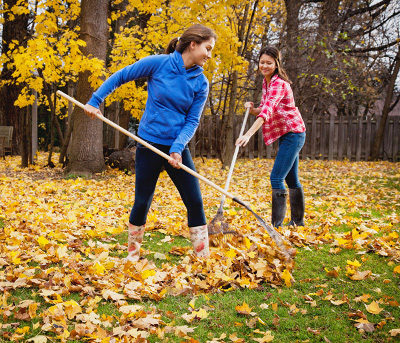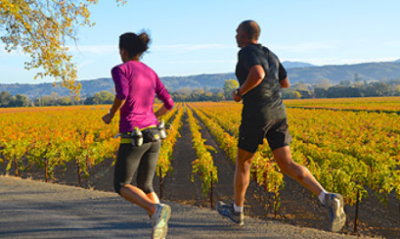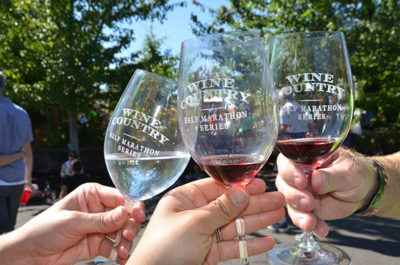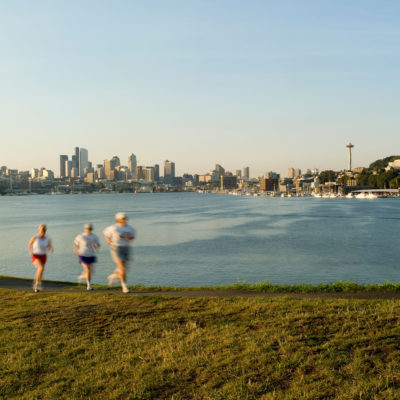Raking Leaves: The Do’s and Dont’s

It’s that time of year again – pumpkin spice latte’s, visits to the pumpkin patch, and hoodies galore! It’s also time for beautiful fall foliage and raking leaves. Raking leaves can provide good aerobic exercise, but it also can everything from blisters to back pain. Check out these handy tips brought to you by Health News Digest to stay enjoying the Autumn leaves this fall!
• Use a rake which is the right size for you. The handle should be chin height and hands should be able to hold the rake 18″ to 24″ apart. A rake that is too short can hurt the back; one that is too heavy can strain shoulders and neck.
• Wear appropriate layers of lightweight clothing.
• Wear gloves to prevent blisters.
• Wear skid resistant shoes – leaves can be wet and cause a fall.
Get it done!
• Warm up muscles with light stretches of the arms, back and legs.
• Alternate hands with raking, and stagger feet to help shift weight.
• Make short strokes, so you don’t overextend muscles.
• Rake to the side, keeping the back straight.
• Bend at the knees, instead of at the back.
• Don’t twist. It’s better to move the legs and pivot the body to shift your weight.
• Be careful not to overstuff the bags. Remember that wet leaves weigh more, so pack less leaves in the bags when they’re wet.
• When moving the bags, make sure to lift with the legs – bend the knees and keep your back straight and stomach tight. If a bag is large and awkward to lift, walk backwards pulling the bag, or use a handcart or dolly to move it.
• Pace yourself and take breaks.
• Remember to stretch after you finish.
Most importantly, listen to what your body is telling you. If you feel intense pain or tingling in your arms, stop immediately and seek medical attention. If you aren’t used to that level of activity, expect to be sore for the first 24 hours after raking. Soreness should improve after that point. Anyone who does not feel better, or feels an increase in soreness, should seek medical attention immediately.
___________________________________________
Aliani, Michele. “Raking Leaves This Fall – Tips to Prevent Injury.” HealthNewsDigest. N.p., 29 Oct. 2014. Web. 24 Aug. 2016.
Golf Giving You Pain?
Golf lovers play rain or shine out her in the Pacific Northwest, but regardless of the weather pain can really slow down your golf game. Especially if that pain isn in your lower back. However, there are ways to play safe and smart that will support your game. Our friends over at Sports PT have put together a list of Tips to keep you and your golf game strong!
1: Reduce your backswing. In the modern golf swing, when we take our backswing, our hips and shoulders rotate away from the target. When our hips naturally stop rotating, our shoulders and trunk rotate even further to coil up the body and get ready to unleash that energy toward the golf ball. This extra trunk rotation can be a vulnerable position for the lumbar spine and often contributes to pain.
2: Walk smart: If you like to walk the course for exercise that’s great, but don’t do it at the expense of your low back. If you like to carry your clubs, make sure you have a bag with two shoulder straps. If you like to use a cart, make sure you push it in front of you, don’t pull it behind you. This will preserve strength in your core muscles to help last the entire round.
3. Don’t’ spend a lot of time on the practice green: The typical putting stroke requires you to bend forward a considerable amount. If you are practicing your putting for a long time, you have already begun to fatigue these important muscles that support good spine posture, and they might not be able to do their job during the actual round of golf.
4. Watch your posture when you are not golfing: If you are a seated professional, keep an eye on your posture during the day when at your desk. Sitting places 2.5 times your body weight on the low back, so it’s important to avoid slouching during the work day.
5. Train your body to succeed at golf: While golf isn’t considered an intense activity by a lot of people, you need specific strength and flexibility to reduce the stress on your spine. You also need good muscular endurance to maintain a consistent swing for up to 5 hours. Seek professional advice and training from a physical therapist that has golf specific knowledge.
______________________________________________
Abel, Tim. “Reducing Low Back Pain In Your Golf Game.” Sports PT | Care in Motion. American Red Cross, July 2016. Web. 26 Aug. 2016.
Woodinville-to-Redmond Wine & Beer Country Half Marathon | September 17th, 2016

Woodinville is the newest addition to the Wine Country Half Marathon Series. Located just 30 minutes to the northeast of downtown Seattle, it’s a thriving mecca of wineries, breweries, restaurants and distilleries. Over 100 wineries now reside in Woodinville, representing grapes from all 13 appellations of Washington state, the 2nd largest wine producer in the country behind California. Nestled in the heart of the beautiful Sammamish River Valley, Woodinville combines urban flair with open space, farmland, and scenic riverside trails. A scenic 13.1 mile course starts among the vineyards at historic Chateau Ste. Michelle and winds it way through the valley, bounded by the cities of Redmond to the south and Bothell to the north. You’ll pass the four unique districts that comprise Woodinville Wine Country and finish alongside the Sammamish River for our trademark Wine + Music Festival featuring fabulous wines, locally crafted microbrews, and so much more!
Check out http://destinationraces.com/runwoodinville/ for more information and registration!

The Leaves Are Coming Down! Fall is almost upon us
Raking Leaves: The Do’s and Dont’s
It’s that time of year again – pumpkin spice latte’s, visits to the pumpkin patch, and hoodies galore! It’s also time for beautiful fall foliage and raking leaves. Raking leaves can provide good aerobic exercise, but it also can everything from blisters to back pain. Check out these handy tips brought to you by Health News Digest to stay enjoying the Autumn leaves this fall!
• Use a rake which is the right size for you. The handle should be chin height and hands should be able to hold the rake 18″ to 24″ apart. A rake that is too short can hurt the back; one that is too heavy can strain shoulders and neck.
• Wear appropriate layers of lightweight clothing.
• Wear gloves to prevent blisters.
• Wear skid resistant shoes – leaves can be wet and cause a fall.
Get it done!
• Warm up muscles with light stretches of the arms, back and legs.
• Alternate hands with raking, and stagger feet to help shift weight.
• Make short strokes, so you don’t overextend muscles.
• Rake to the side, keeping the back straight.
• Bend at the knees, instead of at the back.
• Don’t twist. It’s better to move the legs and pivot the body to shift your weight.
• Be careful not to overstuff the bags. Remember that wet leaves weigh more, so pack less leaves in the bags when they’re wet.
• When moving the bags, make sure to lift with the legs – bend the knees and keep your back straight and stomach tight. If a bag is large and awkward to lift, walk backwards pulling the bag, or use a handcart or dolly to move it.
• Pace yourself and take breaks.
• Remember to stretch after you finish.
Most importantly, listen to what your body is telling you. If you feel intense pain or tingling in your arms, stop immediately and seek medical attention. If you aren’t used to that level of activity, expect to be sore for the first 24 hours after raking. Soreness should improve after that point. Anyone who does not feel better, or feels an increase in soreness, should seek medical attention immediately.
___________________________________________
Aliani, Michele. “Raking Leaves This Fall – Tips to Prevent Injury.” HealthNewsDigest. N.p., 29 Oct. 2014. Web. 24 Aug. 2016.
Stress Fractures: A Common Injury Explained
Stressed about Stress Fractures?!
A stress fracture is a common injury among runners, and can set back your running schedule by an average of 6 weeks! But what exactly is a stress fracture, and how can it be prevented? Well, never fear were here to answer some questions you may have!
What is a stress fracture?
A stress fracture is a small crack in any of the weight bearing bones of the body. The most commonly injured areas of runners are the tibia, or shinbone, and foot.
When am you most likely to get a stress fracture?
Stress fractures happen most often when runners increase their intensity and mileage over several weeks to a few months.
What does a stress fracture feel like?
A stress fracture typically feels like a dull ache along the bone. The pain usually feels localized to the specific spot of the fracture. Typically, it will hurt it you press on it. The pain will get progressively worse as you run on the injury, and it may even hurt if you jump on it.
What is the treatment for a stress fracture?
There is no real treatment other than rest. A physician may prescribe a boot or crutches to help keep the pressure off the affected area. This allows for complete healing of the fracture. If you continue to run and put pressure on a stress fracture it can lead to a bone fracture that could set you back months, and may result in surgery.
How can you prevent a stress fracture?
Check in with your training program and make sure you are not pushing too hard – make sure you’re not making dramatic increases in distance. Strength trying is key to keeping your body up to the increased needs of distance running. Strengthening of your hips, core, quads, and calves can help prevent a stress fractures.
There are so many running activities in Seattle this time of year, so get out there and enjoy them! Just be sure to take care of yourself along the way and listen to what your body is telling you.
Fun Local Upcoming Community Event
Magnuson Family Fitness Day | Sept. 17th 10am
Fitness events are even better when shared with family and friends so make sure to round up the whole family or invite that friend who will help you cross the finish line. We have all events plus a featured duathlon option where you run 2.5 miles, bike 10 miles and then sprint a half mile to the finish!
About the duathlon: This is a great course for all ability levels. Magnuson offers the duathlon race two times a year. The course starts with a 2.6 mile run that follows the 5k course of the runners. At 2.6 miles you reach the bike racks and transition area. Hope on a bike and head out of the park on 65th St. and then North on the Burke Gilman Trail. The bike turnaround is 5 miles out at NE 42nd PL NE. After the turn around you head back to the transition area for the remaining half mile sprint to the finish.
The Duathlon as well as the 5k, 10k, and 15k will start at 10 am. The start/finish line is the same for all events. Perhaps you want to participate in the duathlon as a team? You can have one member do the run and one member do the bike leg, or you can have 3 members do one leg each.
For more information and to register check out www.magnusonseries.org
Making Fitness Stick

How can you seamlessly incorporate fitness into your lifestyle? Good question, and one we’d all like to answer. One way is to shift your perception of what fitness involves. “Fitness” doesn’t have to involve intricate workouts and tricky moves if that’s not your thing. Maybe fitness for you is walking for 20min each night, or making a conscious effort to get out of the office and walk throughout the day. Making it happen can be as easy as finding a goal to train for, or just something that makes you happy.
Fitbit has put together a list of some other science-approved ways to keep fitness simple, so it sticks:
Get Outside
Stepping outdoors has been proven to boost happiness and even cause positive thinking. Researchers at Stanford University recently found 90 minutes of walking in a natural environment can reduce repetitive, negative self-thoughts. In other words, taking a hike in a park-like setting can make you feel better about yourself—which can be pretty motivating!
Buddy Up
Solo exercise can help relieve stress, but for some, a partner makes workouts more fun. Research shows it can help keep you accountable, and one study published in the Journal of Sport and Exercise revealed that exercise adherence is related to perceived support—so knowing your friend has your back can help you stick to your plan. The same study showed the buddy effect can make you feel more positive about your routine, too.
Be Efficient
If a long run seems daunting, get outside for three brisk, 10-minute strolls during the day (and get your steps in). Research has long shown three shorter bouts can have similar calorie-burning benefits as one 30-minute session.
So get out there and enjoy the Seattle sun before it’s gone, and bring a friend with you!
____________________________________________________
“Athlete Tested, Science Approved: 3 Simple Ways to Make Fitness Stick.” Fitbit.com. Ed. Laura Rosenbaum. Fitbit, 26 Apr. 2016. Web. 23 Aug. 2016.
Keep those fitness goals and stay cool at the same time!

Finding it hard to stay cool while exercising outside in the heat? Here are some helpful reminders to beat the heat while still achieving your workout goals!
As we all know when it’s hot outside we want to stay hydrated! This is by far the most important detail when exercising in the heat. Water is the best option, but if your workout lasts longer than 1 hour try considering an electrolyte packed sports drink. Sport drinks contain valuable carbohydrates and minerals to aid in hydration when exercising for long periods in the heat. Be sure to always hydrate before, during, and after each activity.
No matter what type of exercise activity you choose, whether it be running, hiking, or even just a simple evening walk, we always want to be sure to wear clothing that matches the temperature outside. Rule of thumb: always wear loose fitting, breathable, and light colored comfortable clothing when doing anything active in warm weather.
When is the best time of day to exercise in hot weather? Rule of thumb: do not exercise during the hottest periods of the day. If possible, early morning hours and right after dinner are your best bet.
These simple tips are just a few of multiple ways to stay cool when exercising in the heat. Now get out there and enjoy the Seattle sun before it’s gone!
____________________________________________________________
Quick Tips: Staying Active in Hot Weather.” E Medicine Health. Ed. E.Gregory Thompson. WebMD, 25 Oct. 2011. Web. 25 Aug. 2016.

